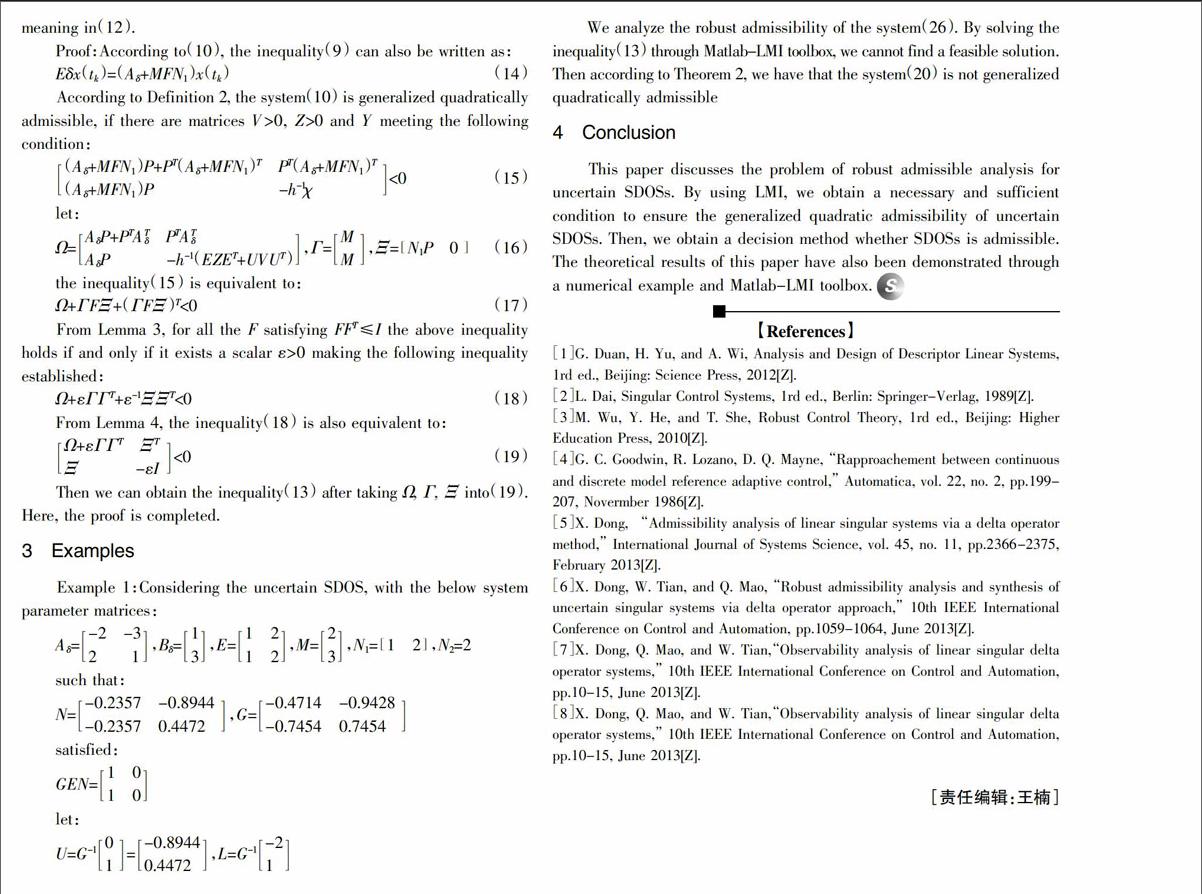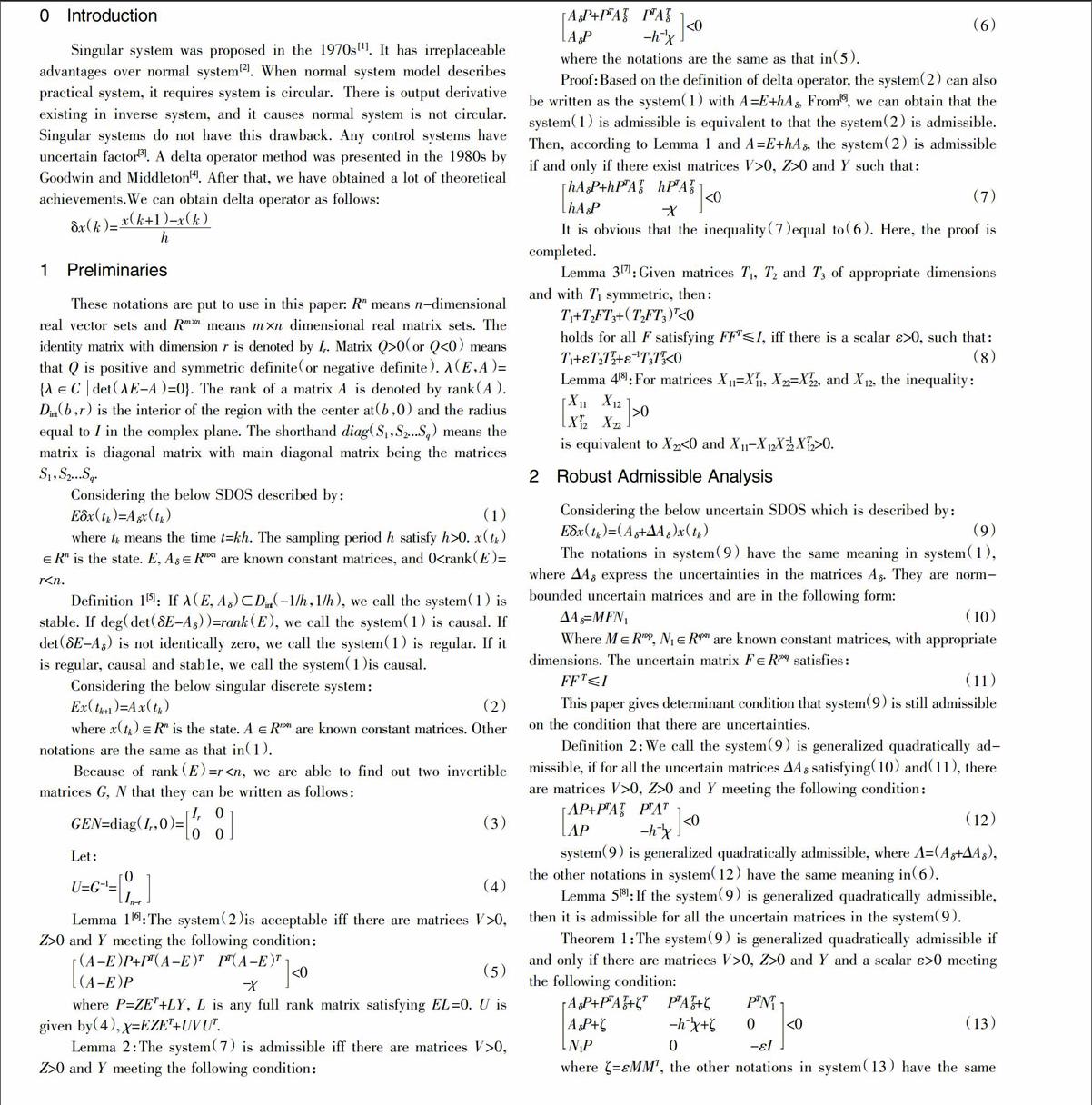Robust Admissible Analyse of Uncertain Singular Systems via Delta Operator Method
2016-04-26WANGWenWANGHui
WANG+Wen WANG+Hui


【Abstract】This paper investigates the problem of robust admissible analysis for uncertain singular delta operator systems(SDOSs). Firstly, we introduce the definition of generalized quadratic admissibility to ensure robust admissibility. Then, by means of LMI, a necessary and sufficient condition is given to prove a uncertain SDOS is generalized quadratic admissible. Finally, a numerical example is provided to demonstrate the effectiveness of the results in this paper.
【Key words】SDOSs; Robust admissibility; LMI
0Introduction
Singular system was proposed in the 1970s[1]. It has irreplaceable advantages over normal system[2]. When normal system model describes practical system, it requires system is circular. There is output derivative existing in inverse system, and it causes normal system is not circular. Singular systems do not have this drawback. Any control systems have uncertain factor[3]. A delta operator method was presented in the 1980s by Goodwin and Middleton[4]. After that, we have obtained a lot of theoretical achievements.We can obtain delta operator as follows:
1Preliminaries
These notations are put to use in this paper: Rn means n-dimensional real vector sets and Rm×n means m×n dimensional real matrix sets. The identity matrix with dimension r is denoted by Ir. Matrix Q>0(or Q<0) means that Q is positive and symmetric definite(or negative definite). ?姿(E,A)={?姿∈Cdet(?姿E-A)=0}. The rank of a matrix A is denoted by rank(A). Dint(b,r) is the interior of the region with the center at(b,0) and the radius equal to I in the complex plane. The shorthand diag(S1,S2...Sq) means the matrix is diagonal matrix with main diagonal matrix being the matrices S1,S2...Sq.
Considering the below SDOS described by:
E?啄x(tk)=A?啄x(tk)(1)
where tk means the time t=kh. The sampling period h satisfy h>0. x(tk)∈Rn is the state. E, A?啄∈Rn×n are known constant matrices, and 0<rank(E)=r<n.
Definition 1[5]: If ?姿(E, A?啄)?奂Dint(-1/h,1/h), we call the system(1) is stable. If deg(det(?啄E-A?啄))=rank(E), we call the system(1) is causal. If det(?啄E-A?啄) is not identically zero, we call the system(1) is regular. If it is regular, causal and stab1e, we call the system(1)is causal.
Considering the below singular discrete system:
Ex(tk+1)=Ax(tk)(2)
where x(tk)∈Rn is the state. A∈Rn×n are known constant matrices. Other notations are the same as that in(1).
Because of rank(E)=r<n, we are able to find out two invertible matrices G, N that they can be written as follows:
GEN=diag(Ir,0)=Ir000(3)
Let:
U=G-1=0In-r(4)
Lemma 1[6]:The system(2)is acceptable iff there are matrices V>0,Z>0 and Y meeting the following condition:
(A-E)P+PT(A-E)TPT(A-E)T(A-E)P -?字<0(5)
where P=ZET+LY, L is any full rank matrix satisfying EL=0. U is given by(4), ?字=EZET+UVUT.
Lemma 2:The system(7) is admissible iff there are matrices V>0,Z>0 and Y meeting the following condition:
A?啄P+PTAT ?啄PTAT ?啄A?啄P -h-1?字<0(6)
where the notations are the same as that in(5).
Proof:Based on the definition of delta operator, the system(2) can also be written as the system(1) with A=E+hA?啄, From[6], we can obtain that the system(1) is admissible is equivalent to that the system(2) is admissible. Then, according to Lemma 1 and A=E+hA?啄, the system(2) is admissible if and only if there exist matrices V>0, Z>0 and Y such that:
hA?啄P+hPTAT ?啄hPTAT ?啄hA?啄P -?字<0(7)
It is obvious that the inequality(7)equal to(6). Here, the proof is completed.
Lemma 3[7]:Given matrices T1, T2 and T3 of appropriate dimensions and with T1 symmetric, then:
T1+T2FT3+(T2FT3)T<0
holds for all F satisfying FFT≤I, iff there is a scalar ?着>0, such that:
T1+?着T2TT 2+?着-1T3TT 3<0(8)
Lemma 4[8]:For matrices X11=XT 11, X22=XT 22, and X12, the inequality:
X11X12XT 12X22>0
is equivalent to X22<0 and X11-X12X-1 22 XT 12>0.
2Robust Admissible Analysis
Considering the below uncertain SDOS which is described by:
E?啄x(tk)=(A?啄+?驻A?啄)x(tk)(9)
The notations in system(9) have the same meaning in system(1), where ?驻A?啄 express the uncertainties in the matrices A?啄. They are norm-bounded uncertain matrices and are in the following form:
?驻A?啄=MFN1(10)
Where M∈Rn×p, N1∈Rq×n are known constant matrices, with appropriate dimensions. The uncertain matrix F∈Rp×q satisfies:
FF T≤I(11)
This paper gives determinant condition that system(9) is still admissible on the condition that there are uncertainties.
Definition 2:We call the system(9) is generalized quadratically admissible, if for all the uncertain matrices ?驻A?啄 satisfying(10) and(11), there are matrices V>0, Z>0 and Y meeting the following condition:
?撰P+PTAT ?啄PT?撰T?撰P -h-1?字<0(12)
system(9) is generalized quadratically admissible, where ?撰=(A?啄+?驻A?啄), the other notations in system(12) have the same meaning in(6).
Lemma 5[8]:If the system(9) is generalized quadratically admissible, then it is admissible for all the uncertain matrices in the system(9).
Theorem 1:The system(9) is generalized quadratically admissible if and only if there are matrices V>0, Z>0 and Y and a scalar ?着>0 meeting the following condition:
A?啄P+PTAT ?啄+?灼T PTAT ?啄+?灼 PTNT 1A?啄P+?灼 -h-1?字+?灼 0N1P 0 -?着I<0(13)
where ?灼=?着MMT, the other notations in system(13) have the same meaning in(12).
Proof:According to(10), the inequality(9) can also be written as:
E?啄x(tk)=(A?啄+MFN1)x(tk)(14)
According to Definition 2, the system(10) is generalized quadratically admissible, if there are matrices V>0, Z>0 and Y meeting the following condition:
(A?啄+MFN1)P+PT(A?啄+MFN1)TPT(A?啄+MFN1)T(A?啄+MFN1)P -h-1?字<0(15)
let:
?赘=A?啄P+PTAT ?啄PTAT ?啄A?啄P -h-1(EZET+UVUT),?祝=MM,?桩=N1P0(16)
the inequality(15) is equivalent to:
?赘+?祝F?桩+(?祝F?桩)T<0(17)
From Lemma 3, for all the F satisfying FFT≤I the above inequality holds if and only if it exists a scalar ?着>0 making the following inequality established:
?赘+?着?祝?祝T+?着-1?桩?桩T<0(18)
From Lemma 4, the inequality(18) is also equivalent to:
?赘+?着?祝?祝T?桩T?桩 -?着I <0(19)
Then we can obtain the inequality(13) after taking ?赘, ?祝, ?桩 into(19). Here, the proof is completed.
3Examples
Example 1:Considering the uncertain SDOS, with the below system parameter matrices:
A?啄=-2-32 1,B?啄=13,E=1212,M=23,N1=12,N2=2
such that:
N=-0.2357-0.8944-0.23570.4472,G=-0.4714-0.9428-0.74540.7454
satisfied:
GEN=1010
let:
U=G-101=-0.89440.4472,L=G-1-21
We analyze the robust admissibility of the system(26). By solving the inequality(13) through Matlab-LMI toolbox, we cannot find a feasible solution. Then according to Theorem 2, we have that the system(20) is not generalized quadratically admissible
4Conclusion
This paper discusses the problem of robust admissible analysis for uncertain SDOSs. By using LMI, we obtain a necessary and sufficient condition to ensure the generalized quadratic admissibility of uncertain SDOSs. Then, we obtain a decision method whether SDOSs is admissible. The theoretical results of this paper have also been demonstrated through a numerical example and Matlab-LMI toolbox.
【References】
[1]G. Duan, H. Yu, and A. Wi, Analysis and Design of Descriptor Linear Systems,1rd ed., Beijing: Science Press, 2012[Z].
[2]L. Dai, Singular Control Systems, 1rd ed., Berlin: Springer-Verlag, 1989[Z].
[3]M. Wu, Y. He, and T. She, Robust Control Theory, 1rd ed., Beijing: Higher Education Press, 2010[Z].
[4]G. C. Goodwin, R. Lozano, D. Q. Mayne, “Rapproachement between continuous and discrete model reference adaptive control,” Automatica, vol. 22, no. 2, pp.199-207, Novermber 1986[Z].
[5]X. Dong, “Admissibility analysis of linear singular systems via a delta operator method,” International Journal of Systems Science, vol. 45, no. 11, pp.2366-2375, February 2013[Z].
[6]X. Dong, W. Tian, and Q. Mao, “Robust admissibility analysis and synthesis of uncertain singular systems via delta operator approach,” 10th IEEE International Conference on Control and Automation, pp.1059-1064, June 2013[Z].
[7]X. Dong, Q. Mao, and W. Tian,“Observability analysis of linear singular delta operator systems,” 10th IEEE International Conference on Control and Automation, pp.10-15, June 2013[Z].
[8]X. Dong, Q. Mao, and W. Tian,“Observability analysis of linear singular delta operator systems,” 10th IEEE International Conference on Control and Automation, pp.10-15, June 2013[Z].
[责任编辑:王楠]
